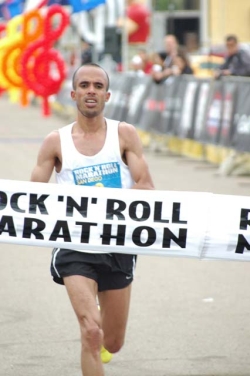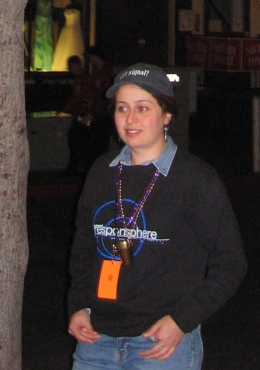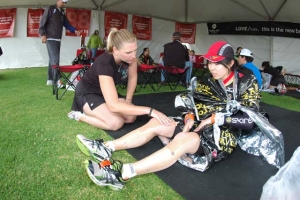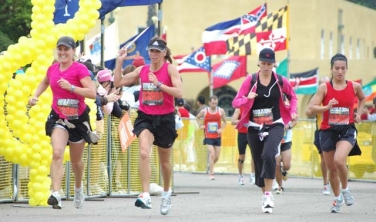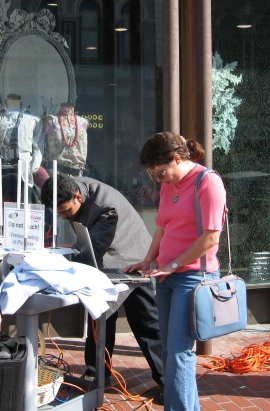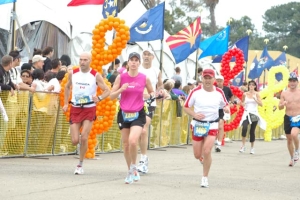Ph.D. Student Observes Medical Command Center at Rock 'n' Roll Marathon
|
San Diego, CA, June 10, 2009 — The cool overcast weather drastically reduced the number of casualties at the 12th annual Rock 'n' Roll Marathon in San Diego, held on May 31, 2009. With over 18,000 participants and 13,000 finishers, it still made an excellent testbed for studying the flow of medical incidents and response. Raheleh Dilmaghani is a Ph.D. candidate in the Electrical and Computer Engineering (ECE) department at UC San Diego's Jacob School of Engineering, and her thesis advisor is Ramesh Rao, director of the UCSD division of Calit2. She has participated in many drills and exercises with other Calit2 researchers on the Responding to Crises and Unexpected Events (RESCUE), ResponSphere and WIISARD disaster-response research projects.
As part of her doctoral research, she is modeling and analyzing communication among first responders at crisis sites and large-scale events, at both the network and organizational levels. Her goal is to mathematically identify and predict bottlenecks and revise the workflow and ultimately, propose a supervisory control to support decision making for efficient response. As part of her data collection, Dilmaghani observed the flow of information inside the Medical Command Center at this year's marathon, and she filed this insider's perspective on the operation of a medical command center at a very large-scale event:
In previous years at the Rock 'n' Roll Marathon, there were large numbers of casualties including runners suffering from heat stroke, seizures, low sodium (water intoxication) and altered levels of unconsciousness. However, this year - thanks to the cool weather - there were only 14 transfers to area hospitals and no one was labeled as "acute."
|
Over the 12 year history of the marathon there have been numerous improvements in the coordination of the Medical Command Center. Currently, the San Diego Fire Communications Center (FCC) deploys a satellite team of emergency medical dispatchers to a tent located near the end of the finish line on the grounds of the San Diego Marine Corps Recruit Depot (MCRD). Four FCC dispatch personnel (whose job is normally to screen and deploy fire and emergency medical service [EMS] resources throughout the city of San Diego) establish an entirely separate communications command center dedicated to race-related needs.
There are over 15,000 runners each year and the potential to overwhelm the day-to-day resources of the city EMS system is real and potentially very dangerous. Therefore, San Diego Fire-Rescue utilizes this stand-alone command center so that they do not interfere with normal city call traffic. Dispatchers employ laptop computers running the "live" FCC computer-aided dispatch (CAD). All City EMS and fire activity is displayed in real-time on a large screen inside the tent. In addition, there is a specific color allocated to ambulances and fire engines dedicated to the race.
The race event coordinator is Elite Racing, a San Diego-based organization that operates numerous "Rock-N-Roll" marathons around the country. They hire a marathon medical director, Louis Maharam, M.D., to supervise Elite personnel. Maharam is the medical director for the New York City Marathon and is a sports-medicine specialist. However, responsibility for the overall organization and management of the system rests with the San Diego Fire Rescue-Department, and many fire personnel are colocated at the medical command center including deputy and battalion chiefs.
|
An efficient mechanism has been created to respond to runners' medical needs on the race course. At each of 26 medical aid stations (one for each mile along the race track), a medical doctor is equipped with a cellphone. There are also several spotters distributed along the course. Any of these individuals may phone an Elite call taker colocated in the Medical Command Center to report a runner "down" and to provide basic medical information. These individuals are told to identify the runner's bib number along with nearby geographic landmarks to aid crews in locating the incident site among the large crowds. This Elite call-taker sits immediately behind FCC dispatch personnel who man the CAD. They receive the information and pass it on a piece of paper to the fire dispatcher who triages the call's acuity and assigns the most appropriate resource.
|
Both basic and advanced life support ambulances are deployed on the course: Basic life support (BLS) ambulances are staffed by EMT's who can provide first aid and essential airway support, while advanced life support (ALS, paramedic-staffed) units can provide definitive airway care and medications. On race day, the San Diego EMS system deploys additional BLS and ALS resources to support the needs of the city given the potential for large numbers of casualties if the weather is hot.
Depending on the perceived acuity of the call, FCC dispatchers (using Medical Priority Dispatch System algorithms) assign one of four resources: Level 1 (simultaneous fire engine with a paramedic) plus an ALS ambulance "lights-and-sirens"; Level 2: ALS ambulance, "lights-and-sirens"; Level 3: ALS ambulance, no "lights-and-sirens" and Level 4: BLS ambulance, no "lights-and-sirens." Fire dispatchers assign the resources using the CAD and communicate basic information to the responding crews. Callers are told not to hang up until told to do so by dispatchers to ensure the receipt of complete information. Elite call-takers may direct questions to the marathon medical director Maharam as needed.
|
This system is efficient for FCC dispatchers as it frees them from becoming involved in information collection. The physical proximity between Elite call-takers and Fire dispatchers adds to the efficiency. Old-fashioned pen and paper works well and quickly. Elite dispatchers do not have a computer in front of them, just a basic landline phone. Before runners leave the marathon finish line area, they are informed that this is their last chance to receive any medical attention. Upon their consent to leave the area, they are responsible for their own well-being. This year, only 14 of approximately 18,000 runners were transported to area hospitals.
Observation Highlights
The physical proximity of all the people being in the same control and command tent is a plus. The presence of James Dunford, M.D., the city of San Diego EMS medical director, with great medical expertise and higher authority helped with resource allocation and life-and-death-related decision making. The distributed supervisory control with possible mobility of a few members helped with removing the bottleneck where everyone may need to talk to one supervisor or in the case of a broken or busy communication line.
Secure access to the data among different responders including fire departments, hospitals and other first responders would be possible over a wireless network, such as Calit2's CalMesh. CalMesh is an ad-hoc network of small, lightweight, and easily reconfigurable nodes that quickly self-organize to form a reliable wireless mesh network. Satellite, wireless or other available technology could then connect the local network to the Internet and provide connectivity with additional decision makers off-site.
Enhanced 9-1-1 Call Handling in San Diego
Outside the race, typical 9-1-1 calls continue to be managed in the normal way. Landline 9-1-1 calls in the city of San Diego are directed to its Public Safety Answering Point (PSAP) at the San Diego Police Department (SDPD) call-center located downtown at police headquarters. Police call-takers initially sort calls for police, fire and ambulance need. Should fire or EMS resources be needed, the call is automatically forwarded the city's Secondary Safety Answering Point (SSAP) at the Fire Communications Center near Montgomery Field airport. There are two types of 9-1-1 systems, regular 9-1-1 and "enhanced" 9-1-1. The city is equipped with enhanced 9-1-1, which automatically identifies the requesting party's phone number and address. This is referred to ANI-ALI, for "Automatic Number Identification-Automatic Location Information." Emergency dispatchers are required to ask for the caller's location and the nature of problem to verify the address of the actual emergency. Unfortunately, the SDPD and FCC CADs are not linked to each other for easy data sharing; this remains a goal of an upgraded communications system for the city.
|
Currently in the San Diego region, 9-1-1 calls from cellphones are forwarded to a different PSAP, located at the California Highway Patrol (CHP). There are not precise statistics available on how long it takes to receive and process CHP calls, although delays are common. One reason is the large numbers of cellphone calls which are redundant, reporting the same incident. No call can be ignored; therefore multiple calls increase the waiting time in the "queue" for other callers. Therefore, it is crucial to use a landline phone, when possible, to call 9-1-1 in a life threatening situation. As cellphone towers and global position systems are enhanced, it is expected that individual cellphone calls will be able to be routed directly to the most appropriate PSAP.
Many thanks go to Dr. James Dunford, Professor of Clinical Medicine and Surgery, UCSD Department of Emergency Medicine and City of San Diego Medical Director (EMS), for his insights, conversations and review of this article, and to Maureen C. Curran for editing it for website publication.
Related Links
RESCUE project
ResponSphere project
WIISARD project
Rock 'n' Roll Marathon

